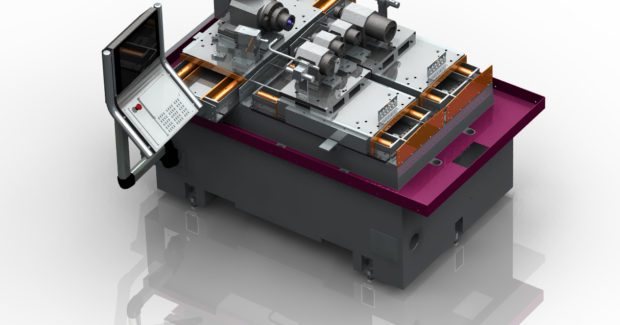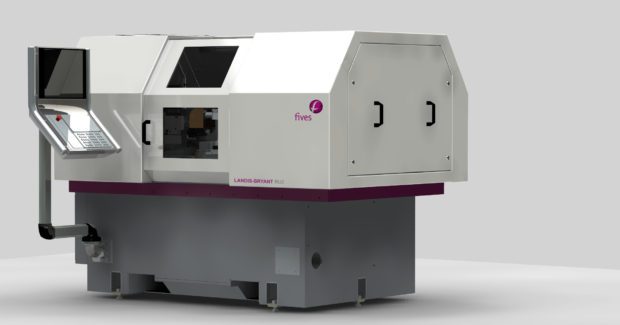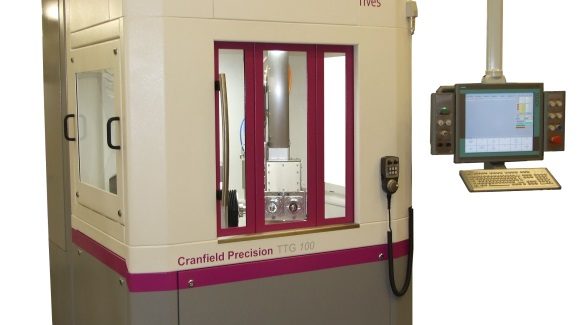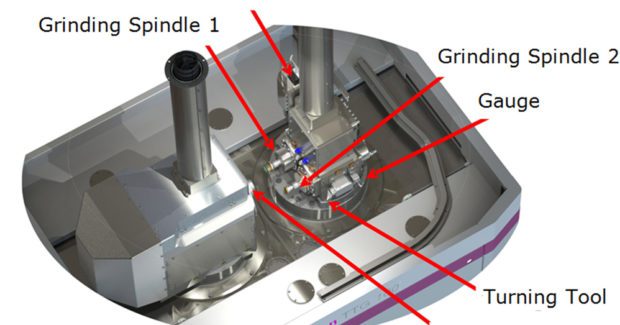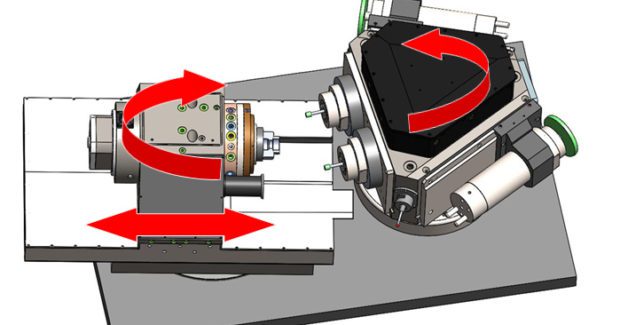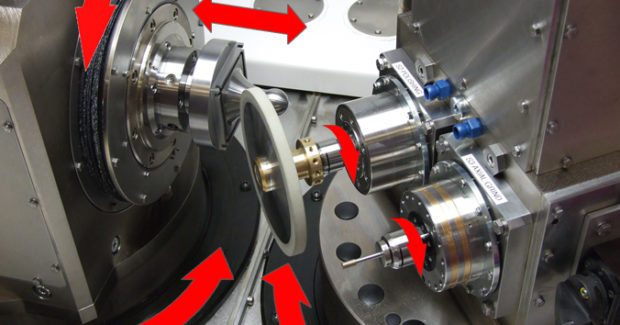Grinding Fuel Systems, Valve and Drive Trains, Bearings, Aerospace, Medical Parts
The Landis-Bryant RU2 Fuel MGMT grinder, Landis-Bryant RU1, UL2 and UF2 grinders, and the Universal Landis Twin Turret grinding machine from Fives Landis all feature high-precision technology for grinding the most complex components.
Posted: July 31, 2016
In Booth N-7018, Fives Landis Corporation (Hagerstown, MD) will debut their Landis-Bryant RU2 Fuel MGMT grinder, a model of high-precision grinding technology that incorporates a modular multi-surface grinder with extended flexibility to grind most complex components for fuel systems, valve and drive trains, bearings, aerospace and medical applications. The Landis-Bryant RU2 Fuel MGMT grinder is specifically designed for the challenging requirements of fuel system components that require tight control over related features during grinding operations through a single handling. It employs a dual-slide arrangement in the Z-axis that can accommodate up to six grinding spindles. A 4-spindle model will be demonstrated at the show, with a coolant through 90,000 rpm, ID spindle and multiple dressing options.
Landis-Bryant RU2 grinders offer multi-slide possibilities in both the X- and Z-axis with multiple work heads, wheel heads, and dressing systems that make the machine ideal for process operations such as bore, seat, and face. Its granite epoxy bed includes a thermal stability system to monitor the temperature and, together with the optional adaptive thermal compensation, provides ultimate thermal stability. A stiff hydrostatic round-bar guideway system enables precise location of all axes, resulting in ultimate dimensional and geometric accuracy through high-resolution Heidenhain glass scales and Fanuc linear motors. Modular design enables flexibility and allows customers to choose from multiple sizes, a tremendous range of machine configurations of work spindles, grinding spindles, dressing spindles, slides, tooling and fixtures and the ability to handle parts up to 14 in (350 mm) in diameter and 7 in (177 mm) long. Landis-Bryant RU2 grinders can be configured as chucker, shoe centerless and center-type systems.
“We acquired Bryant Grinders in 2015 to extend our expertise in the design and manufacture of high-precision/high-production inner-outer diameter grinders,” said Dwight Myers, the chief executive officer of Fives Landis. “The acquisition broadened our Grinding | Ultra Precision portfolio in the bearing, drive train, fuel systems, medical and valve train industries, and provides a full range of aftermarket services to the installed base of Bryant grinding machines, including parts, field service, machine remanufacture and control retrofits.”
Other grinders in the Landis-Bryant lineup include the Landis-Bryant RU1, UL2, UF2 and Landis-Bryant Spindles. The Landis-Bryant RU1 is a single-spindle machine for small precision part processing such as bearings, fuel systems, valve train, optical and medical applications. The Landis-Bryant UL2 is best suited for high production / high precision grinding bores and faces in bearing rings, universal joint cups, valve lifters and gears, while the Landis-Bryant UF2 is engineered for high production / high precision grinding of external diameters, faces, and forms. A complete line of precision spindles is offered, with infinitely variable speeds up to 120,000 rpm. Landis-Bryant spindles contain super-precision bearings that permit operation at extremely high speeds and are powered by in-house-designed induction motors to provide superior performance for efficient machining. Spindles are standard on new machines, specified for rebuilds and available for any other equipment that requires precision spindles.
Also being showcased will be a high-precision Universal Landis Twin Turret grinding machine with a newly configured design that provides a common platform for multiple machine configurations and processes. It is far stiffer than conventional machines, features remarkable thermal stability, and offers a compact machine footprint. Fives’ longtime grinding expertise, in conjunction with its history alongside the Landis and Cranfield Precision range of products, led to the development of the Universal Twin Turret grinder. Landis Twin Turret (LTT) series machines are designed for superabrasives and perfectly suited to process extremely challenging materials and geometries common in various industries and markets such as aerospace, automotive, fuel systems as well as optics and precision components. This model provides a common platform for multiple machine configurations and processes, including OD, ID and profile grinding, milling, polishing, hard and diamond turning, dicing, and in-situ metrology. Supplied in two sizes, the LTT-100 and LTT-400 are multifunctional machines that handle workpieces as large as 100 mm and 400 mm in diameter, respectively.
The Universal Twin Turret grinder enables sub-micron position control. Two rotary axes are rigidly mounted on a fixed center distance and provide relative motion between the component and cutting tool, with the linear axis used to control the depth of cut and profile shape of the component being machined. Its unique combination of rotary and linear axes produce relative motion between tool and workpiece over a swept working area. This machine concept is radically different, as it coordinates the two rotary axes and a short linear axis in a Twin Turret design to provide far stiffer results than standard machines, as well as remarkable thermal stability. Gone are the inherent thermal stability and stiffness issues that plague conventional machine platforms using stacked linear axes.
The twin turret design enables a simple non-contacting labyrinth seal, making the machine base almost immune to distortions. A far cry from traditional machine designs that suffer from the ever-changing coolant return path and heat transference from the grinding process, resulting in constant variable machine distortions. The LTT was designed to use the minimum number of bearing interfaces in the machining loop, to maximize machine loop stiffness. Two highly damped hydrostatic bearings are employed and the machine’s turrets are bolted together via a solid granite base plate to resist machining forces and improve precision and repeatability. The unique configuration of the LTT also provides a compact machine footprint that is typically 40 percent smaller than similar machines. This frees up more room on the job shop floor for other workpieces, additional work-flow margin, and/or space for inventory.
Fives Landis Corporation, 16778 Halfway Boulevard, Hagerstown, MD 21740, 301-797-2981, Fax: 301-797-2820, www.grinding.fivesgroup.com.





